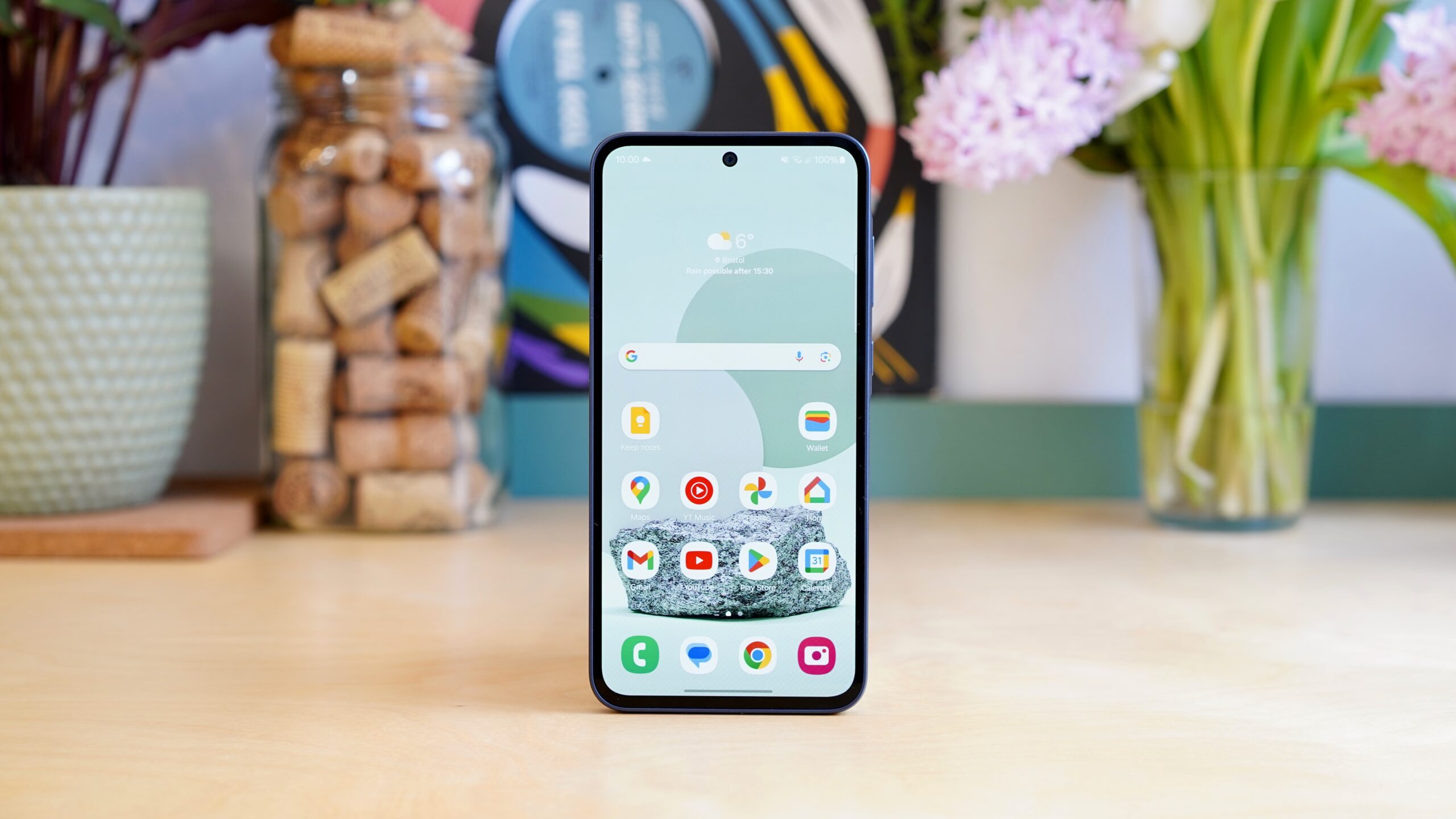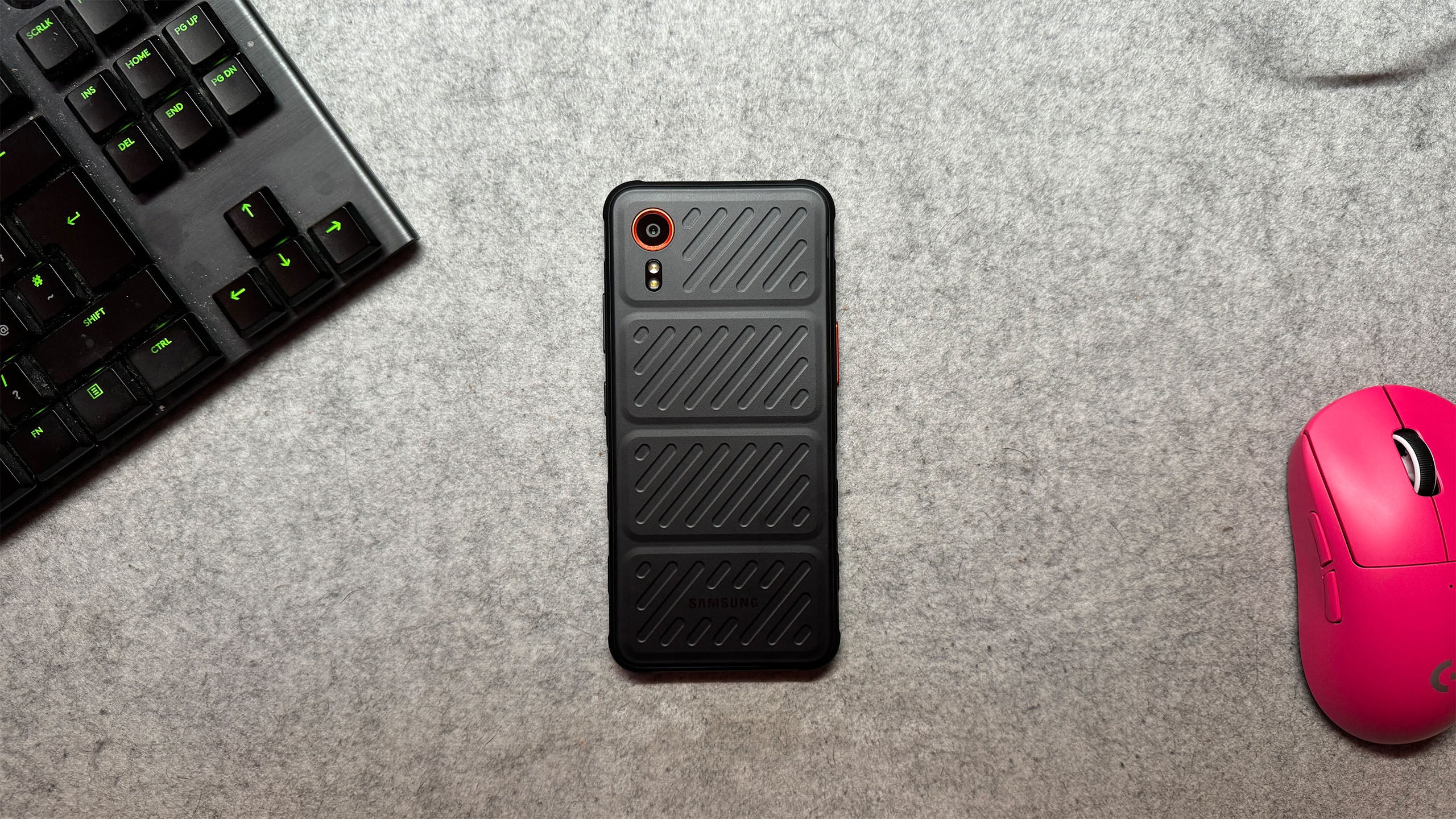Samsung Galaxy A54 5G Review
A fine, if not exceptional, mid-ranger


Verdict
The Samsung Galaxy A54 is a solid mid-ranger that ticks most boxes – it has a great display, premium build, a decent camera setup and a large battery – but slight performance niggles and inconsistent battery life stop it from being an instant recommendation.
Pros
- Premium look and build
- Great 120Hz AMOLED display
- Huge 5,000mAh battery
- New and improved 50MP camera
Cons
- Inconsistent battery life
- No display HDR support
- Can be a bit slow at times
- Slow charge times
Availability
- UKRRP: £449
- USARRP: $449
- EuropeTBC
- CanadaTBC
- AustraliaTBC
Key Features
- Premium materialsThe use of a glass rear in place of the plastic of last year’s A53 5G gives the A54 a more premium look and feel.
- 120Hz AMOLED displayThe 120Hz AMOLED display delivers bright, crisp visuals with buttery smooth animations.
- Upgraded camera setupThough it looks like a downgrade on paper, the 50MP snapper boasts a larger sensor and bigger pixels for improved image quality.
Introduction
The Samsung Galaxy A54 5G looks to be a tempting upgrade for those on the hunt for a mid-range device, boasting a refreshed design, high-end materials and the promise of two-day battery life.
The upgraded materials mean Samsung’s £449 Galaxy A54 feels great, and the upgraded 50MP camera with a larger sensor should provide a jump in quality compared to its predecessor, but is it enough to tempt consumers from popular mid-range alternatives like the Google Pixel 6a?
After spending a week using the Samsung Galaxy A54 as my main smartphone, I’m conflicted. Certain areas certainly stand out among the mid-range competition, but some key areas are still lacking and stop the A54 from being an instant recommendation.
Design and screen
- New Galaxy S23-like design
- Glass rear helps it feel premium
- 6.4-inch 120Hz AMOLED display
The Samsung Galaxy A54 5G has had quite the upgrade in the design department compared to its predecessor, the Galaxy A53 5G, though you might not notice it by looking at it front-on.
That’s because most of said change is happening on the rear of the phone. The most immediately noticeable is that Samsung has ditched the contour camera housing present on last year’s model, instead opting for the same minimalistic design as the flagship Galaxy S23 line.

The simple trio of lenses on the rear is certainly one of the cleaner looks around, especially compared to rivals that use huge circular and rectangular camera housing. I personally think it’s a little too minimalistic, bordering on the bland, but I’m sure there will be some that really appreciate the new look.
At least there are some stunning colour options available to jazz up the simplistic design, coming in particularly vibrant shades of Lime and Violet, along with a more muted Graphite and Silver. The lime green finish is a personal favourite of mine, with a vivid flash of colour that looks gorgeous in real life.
The other big upgrade for the Galaxy A54 is the material used; rather than going for ‘glasstic’ (that’s plastic to you and I) Samsung has given the A54 the premium treatment with a full glass rear.
It immediately makes the phone feel more premium, especially compared to the plastic Galaxy A34. It also adds a bit of heft, but not to the point where it feels substantial in the hand. At 202g it’s just heavy enough to feel premium without going to the extremes of the 240g iPhone 14 Pro Max.
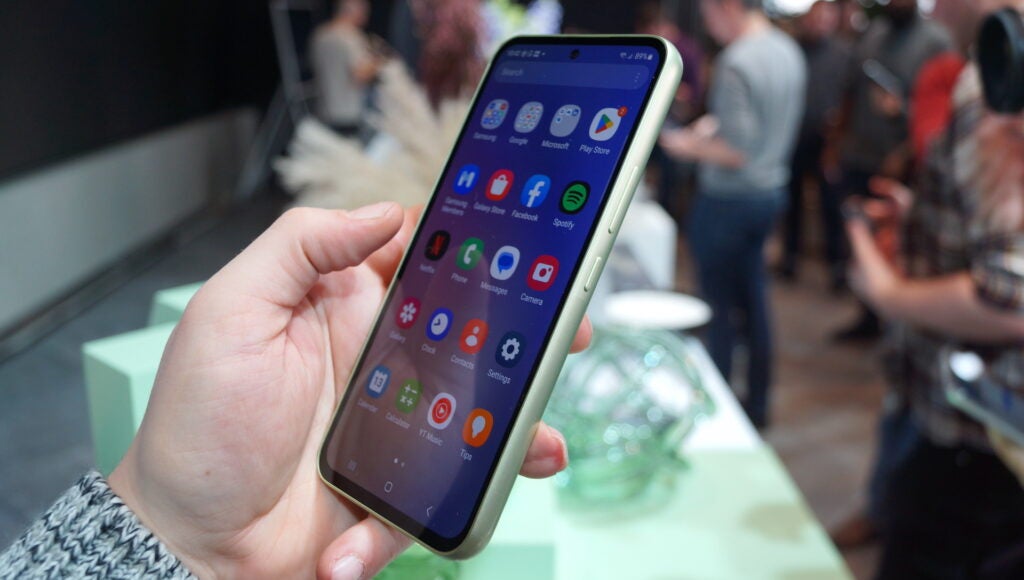
It also sports the more rounded corners of the Galaxy S23 range, which helps the phone stand out from a sea of similar-looking mid-range alternatives, and IP67 dust and water resistance should protect it from most accidents.
New design changes aside, it’s very much business as usual for the Galaxy A54, sporting a power button and volume controls on the right, a USB-C port on the bottom and a combined SIM and microSD card tray. The latter is a nice touch, allowing you to expand storage by up to 1TB if required – I wish it was a feature of the flagship S23 range too.
The 6.4-inch AMOLED panel sports an ‘Infinity O’ design that, to you and I, simply means it has a single hole-punch camera cutout in the middle of the display. It’s the easiest way to tell the difference between it and the Galaxy A34 with its ‘Infinity U’ design.
The combination of the FHD+ resolution and 120Hz refresh rate is nice, though it remains unchanged compared to last year’s A53 and text can sometimes look a little soft if you’ve experienced anything higher, though most consumers likely won’t notice. It would’ve been nice to see a jump to a higher refresh rate like the similarly priced 144Hz Motorola G200, but it’s arguably much of a muchness at that point. It felt buttery smooth when zipping around the UI, at the very least.
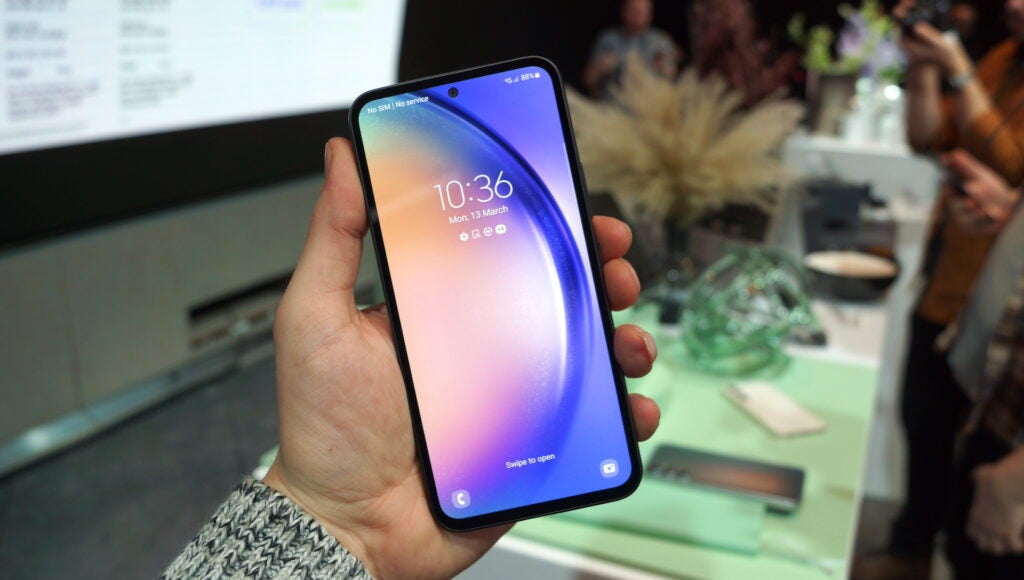
The display is dynamic, dropping between 60Hz and 120Hz depending on what you’re doing, though you can also force a 120Hz refresh rate at the expense of battery life. It won’t drop down to a battery-saving 1Hz, but what mid-range phone does?
All that said, my final impressions of the display are largely positive; it’s big enough to comfortably watch YouTube videos and movies on Netflix, colours are vibrant and punchy (if not a little too vibrant) and it’s easily legible in direct sunlight with a maximum brightness of 1000nits. I did miss elements like HDR10+ when watching Netflix though, features you can find on the likes of the Redmi Note 12 Pro Plus 5G and Google Pixel 6a.
Camera
- New 50MP camera boasts all-around improvements
- Ultrawide and macro lenses remain unchanged
- 32MP selfie camera
The camera setup, at least where the main lens is concerned, looks like a downgrade – on paper, that is.
Yes, the megapixel count has dropped from 64MP to 50MP with the Galaxy A54, but it’s worth noting that it’s a completely new camera with a larger sensor, larger pixel size (0.8um to 1um, or 2um if you pixel-bin) and an enhanced OIS.
That translates to pretty decent image capture in my experience – in well-lit conditions, anyway. Daylight images have plenty of detail and the colours pop, though they’re slightly more vivid than real life in true Samsung fashion. Still, it makes for vibrant shots most of the time, perfect for sharing on social media.


HDR performance is also notable, with the phone able to capture the detail of foreground subjects even with heavy backlighting from the sun.

Low-light photography has improved compared to last year’s A53 with a larger sensor and improved OIS, but it’s still not quite up there with the best around. Images are relatively detailed overall, and there are decent amounts of light captured, but they can still look a little dark and flat compared to what I was seeing in the moment.

To be honest, it would’ve been pretty decent for the money had Xiaomi not released the Redmi Note 12 Pro Plus 5G and its 200MP sensor that truly excels in low light.
Still, results across the board are fairly acceptable for the price tag. What isn’t acceptable, however, is the autofocus performance.
It’s an element I’ve had plenty of issues with during testing, with the phone struggling to focus quickly on subjects when first opening the Camera app – it sometimes took me putting my hand in front of the lens to force the focus change before it’d correctly grab focus. It’s not an issue exclusive to photography either, with videos suffering the same fate, especially if you’re tempted to zoom into a subject mid-recording.
The disappointing focus performance is a bit of a surprise given Samsung’s camera prowess at the top end of the market – so much so that I’m confident that Samsung will fix the issue with a future software update. For now, though, the autofocus is one of the phone’s biggest weaknesses.

The main sensor is backed up by a 12MP ultra-wide and a 5MP macro lens. The former is fairly decent for capturing expansive shots with a wide 0.5x zoom, though it’s best used in well-lit conditions, sporting an aperture of f/2.2 that can make things look a little soft and dark in low-light conditions.
The 5MP macro lens is the most niche of the collection, and something I don’t think many people will use more than once with a fixed focus that makes it difficult to capture anything of note. The fact that the macro shooting mode is found in the ‘More’ section of the camera app, rather than one of the main shooting modes, says a lot about how Samsung views it.
Flip the phone over and you’ll find a 32MP hole-punch selfie camera embedded into the top of the display that’s more than enough for selfies and video calls, but as you might expect, most photography should be left to the rear lenses.

Performance
- Exynos 1380 chipset
- The occasional stutter is present
- Samsung OneUI 5.1 based on Android 13
Unlike the Galaxy A34 which has ditched Samsung’s own processor for a MediaTek equivalent, Samsung’s Galaxy A54 sports an upgraded Exynos 1380 chipset – the latest one in the company’s roster having been revealed just a few weeks prior to the phone’s announcement.
That’s paired with 8GB of RAM regardless of whether you opt for the 128GB or 256GB variant, with the ability to use spare ROM as RAM in performance-hungry apps. You’ve also got the option to boost storage by up to 1TB with a microSD slot, something that’s missing from Samsung’s flagship range.
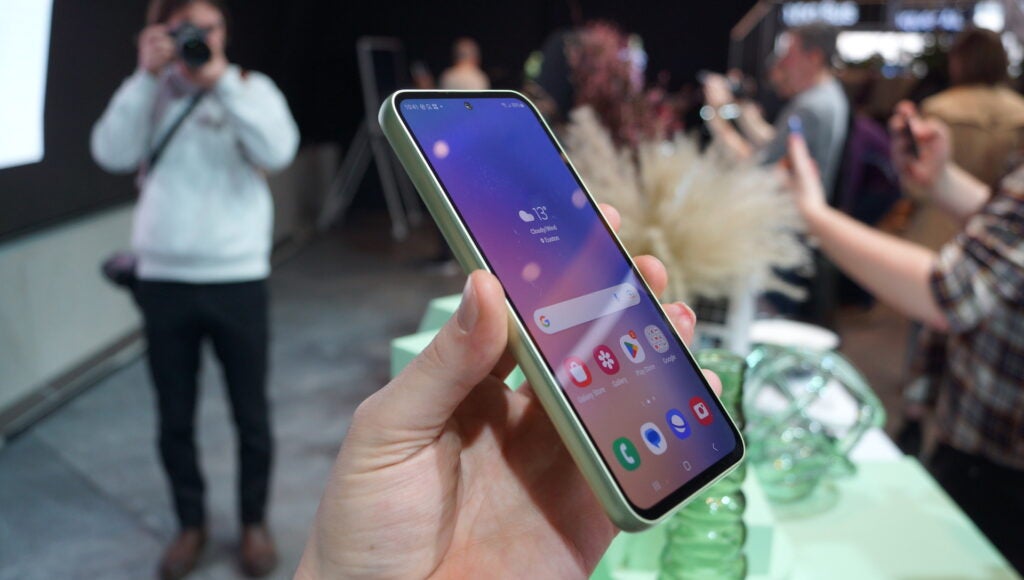
With all that said, don’t expect flagship-level performance, but day-to-day performance is fairly decent and likely enough for casual smartphone users. I could scroll through media-heavy apps like Twitter and Facebook without much stutter or slow-down, and the phone could run top-down shooter Survivor.io with high-level graphics enabled – though the 2D cartoon-style game isn’t nearly as graphics-intensive as titles like CoD Mobile.
However, the experience wasn’t perfect. The transition from lock screen to home screen can sometimes take a second, for example, with the phone hanging on a blurred screen before loading your app icons and widgets. I also noticed framerate drops when playing the fairly basic Survivor.io for more than 30 minutes, which doesn’t bode well for longer gaming sessions.
Elements like switching between the main and ultrawide lenses can also take a second or two, which isn’t ideal if you’re trying to capture a quick snap of your pets or children doing something funny.
So, yes, while you’ll have a relatively smooth experience, it’s not quite as rapid as some power-hungry users might like. That’s backed up by our benchmarks too, with a multi-core score of 2703 in Geekbench 6 and just 810 in 3DMark. Things aren’t that much more encouraging in GFXBench, managing just 19fps in the high-end Aztec Ruins test.
You’ll also get decent connectivity with the inclusion of 5G connectivity and the upgraded Wi-Fi 6 alongside Bluetooth 5.3 and NFC. There isn’t a headphone jack though – that may be rare at the flagship level, but it’s still relatively common among mid-rangers like the Redmi Note 12 Pro Plus 5G.
When it comes to software, the phone ships with Samsung’s latest OneUI 5.1 based on Android 13. It’s very much the usual affair with Samsung’s signature UI design and heavy reliance on Samsung-branded apps, but with small new features like the ability to use certain Snapchat filters within the native Camera app thanks to a new partnership between the two companies.
Battery life
- Large 5000mAh battery
- Battery life depends heavily on what you’re doing
- 25W charging is too slow for the size of the battery
Samsung wanted to go big on battery life with its A series with both the Galaxy A54 and its cheap Galaxy A34 sibling sporting the same 5,000mAh battery that’s found in the top-end flagship S23 Ultra, which is also bigger than that of the S23 and S23 Plus.
On paper that sounds pretty damn impressive, especially when coupled with Samsung’s claims of two days on a single charge, but that doesn’t always reflect real-world usage.
On an average day, the Galaxy A54 was serviceable. I could take it off charge at around 7:30am, use it sporadically through the day to listen to music, scroll through Instagram and reply to WhatsApp messages. It’d reliably end the day at around 11:30pm with around 40% battery left in the tank. That’s pretty good.
However, when I took the phone to Paris for a separate phone launch, battery life began to falter.

Starting at 6:00am, I used the Galaxy A54 for texts, replying to work messages on Slack, replying to emails on Gmail and taking photos of Parisian architecture and I barely made it back to the hotel with 3% battery at 11pm – and that’s with me consciously using it less in the evening because of its dwindling battery life.
That’s also without using the phone to listen to music and otherwise kill time on the two-hour trip from London to Paris via Eurostar, so I thought I’d put that to the test on the way home. Reader, I was very disappointed. I took the phone off charge at around 10:30am, used it for maps, listening to music and playing a couple of games on the Eurostar and the battery dwindled to just 30% by 3:30pm. Safe to say it didn’t make it until that night without a top-up.
That’s backed up by benchmarks too, with tasks like watching Netflix for an hour using 7% of battery while 30 minutes of light gaming drained 8% – the latter is quite the jump compared to Qualcomm-enabled phones like the (admittedly much more expensive) OnePlus 11 and its 4%, despite a higher-res display.
Charging isn’t quite up there either, especially when powering such a large-capacity battery, capping out at just 25W – and you don’t get a charger in the box either. That means that even once you’ve sourced a charger, the process is slow, reaching just 41% in half an hour of charging, with a full charge taking 1 hour and 33 minutes.
Compared to similarly priced phones like the Realme GT 3 and its 240W charging that can go from flat to full in 9.5 minutes, that’s pretty damn slow.
Latest deals
Should you buy it?
You want a solid all-rounder: The Galaxy A54 boasts a decent design, a pretty good display, a capable main rear camera and a large battery.
You want the best performance possible: Even with the upgraded Exynos 1380, the Galaxy A54 isn’t quite as powerful as some key rivals like the Pixel 6a.
Final Thoughts
The Samsung Galaxy A54 is a decent all-rounder with a hint of a truly premium build thanks to a glass rear and an updated design that brings it pretty close to the flagship Galaxy S23 range. IP67 support, in particular, is notable at this price point.
That’s backed up by a punchy, bright 120Hz AMOLED display, though the omission of any kind of HDR support will be disappointing for binge streamers.
The main 50MP camera is another key upgrade for this year’s model, further improving performance in both well-lit and low-light conditions with plenty of light and detail on offer for the price tag.
Performance is pretty decent for the price much of the time, but even simple tasks like unlocking the phone, switching cameras and playing games for extended periods can highlight the limitations of the mid-range chipset.
Battery life is also a little hit-and-miss. As long as you’re not using the phone too often it should last, but even a 5000mAh battery can’t always provide comfortable all-day battery life if you’re really putting the phone to the test. Combined with slow 25W charging, there’s still a lot to be done here.
With all that said, Galaxy A54 5G is a solid all-rounder that’ll do most things well, but it’s not quite as exciting or boundary-breaking as other mid-range options in 2023.
How we test
We test every mobile phone we review thoroughly. We use industry-standard tests to compare features properly and we use the phone as our main device over the review period. We’ll always tell you what we find and we never, ever, accept money to review a product.
Find out more about how we test in our ethics policy.
Used as a main phone for the review period
Thorough camera testing in a variety of lighting conditions
Tested and benchmarked using respected industry tests
FAQs
While the Galaxy A53 offered HDR10+ support, that has been dropped on this year’s model.
While the headphone jack is still a popular feature in some mid-rangers, the A54 doesn’t have one.


